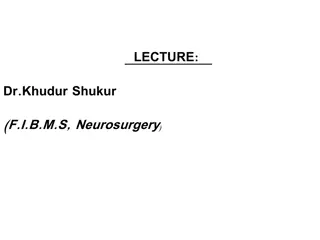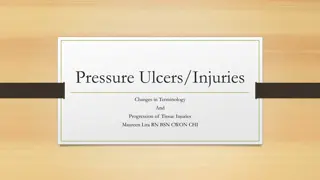Dealing with sports injuries
Anita Turbak, Faculty of Medicine at Rzeszów University, discusses the aims of physiotherapy after sports injury, ways to classify sports injuries, and treatment for soft tissue injuries.
0 views • 15 slides
Spinal injuries
An overview of spinal injuries, including anatomy revision, types of spinal fractures, assessment, management, and common patterns of injuries. It also covers back pain presentation, red flags, differentials, and the structure of vertebrae. The Denis classification of spinal fractures and the most c
3 views • 40 slides
PHYSIOTHERAPY IN KNEE JOINT INJURIES
Explore the anatomy of the knee joint, common knee injuries like meniscus tears and ACL ruptures, and the role of physiotherapy in treatment and rehabilitation. Learn about exercises, gait training, and post-surgical care for knee injuries.
2 views • 12 slides
Comprehensive Guide on Injury, Poisoning, and External Causes
This detailed guide covers various aspects of injuries, poisonings, and other consequences from external causes. It includes information on ICD10 and ICD9 coding, recording and treatment details, vocabulary related to different types of injuries, body parts classification, and code structures for di
2 views • 39 slides
Safe Lifting Techniques to Avoid Ergonomic Injuries: A Comprehensive Guide
Ergonomic injuries are a significant concern in the workplace, with musculoskeletal disorders being a common result. This tutorial explores the risks faced by movers/material handlers and provides insights into safe lifting techniques to prevent injuries. Understanding the importance of ergonomics i
6 views • 21 slides
Needlestick Injuries Prevention and Safety
Prevent needlestick injuries by avoiding unnecessary needle use, using devices with safety features, and implementing safe work practices. Healthcare professionals should report injuries promptly, participate in training, and get vaccinated. Be cautious when handling surgical sharps to prevent injur
5 views • 10 slides
Cold Weather Injuries Prevention Training
This slide deck focuses on preventing, identifying, and treating cold weather injuries. It emphasizes the responsibility of both individuals and commands in preventing cold injuries, highlighting factors contributing to susceptibility and methods for regulation body temperature in cold environments.
3 views • 41 slides
If you are searching for Sports Injuries in Collingwood
If you are searching for Sports Injuries in Collingwood, SportsHealth Physiotherapy & Podiatry Clinic is a general physiotherapy and sports injury clinic located in Richmond. Having been operating in the Kew, Abbotsford and Richmond community, we pride ourselves in delivering high quality clinical s
0 views • 6 slides
Uncovering the Neglected Field of Injury Epidemiology
Exploring the realm of injury epidemiology, this content delves into the definitions, objectives, and hypotheses surrounding the study of injuries. It highlights the overlap between injury epidemiology and prevention while shedding light on why this field remains neglected, particularly in Canada. T
0 views • 70 slides
Managing Sports Injuries: Prevention and Treatment Strategies
This content covers various sports injuries, ways to reduce risks, treatment of injuries including R.I.C.E method, and different drugs used in sports like anabolic steroids, beta blockers, peptide hormones, and the concept of blood doping. It also touches upon benefits, risks, and examples related t
0 views • 11 slides
2018 Mortality Statistics: Life Expectancy, Drug Overdose, Maternal Mortality Released
Mortality statistics for 2018 were released on January 30, 2020, highlighting life expectancy trends, drug overdose statistics, and the first maternal mortality rate in over a decade. A comprehensive communications strategy was executed to disseminate the data, including a new website, visual abstra
0 views • 9 slides
Workplace Safety: Preventing Back Injuries for a Healthier Future
Understanding the importance of back safety in the workplace to prevent debilitating injuries and costly consequences. Learn proper lifting techniques and back care basics to safeguard against back problems. Discover why back injuries occur and how to protect your spine for long-term well-being.
1 views • 48 slides
Understanding Needle Stick Injuries and Prevention
Needle stick injuries are percutaneous piercing wounds caused by needles or other sharp instruments. They pose significant risks, including exposure to blood-borne diseases. Health-care workers are particularly vulnerable, with millions experiencing such injuries annually. Proper training, safe prac
0 views • 35 slides
Understanding Acute Knee Injuries: Meniscal Tears and Ligament Injuries
Acute knee injuries, such as meniscal tears and ligament injuries, are commonly caused by trauma or twisting motions. Meniscal tears can lead to pain, swelling, and locking of the knee joint, especially in young active individuals. Understanding the anatomy of the knee joint and meniscus, along with
0 views • 56 slides
Understanding Vehicle Collisions: Causes, Types, and Injuries
Vehicle collisions involve various types such as front impacts, side impacts, and rear-end collisions, resulting in different injuries like back and head injuries, neck injuries, soft tissue damage, broken bones, and internal injuries. Understanding the causes and effects of collisions can help prev
0 views • 14 slides
Unintentional Beamforming in IEEE 802.11-19/2032r4
Contribution on unintentional beamforming in IEEE 802.11-19/2032r4 addressing potential problems and solutions for secure ranging, involving issues with signal interference and power diminishing. Discussions include the impact on received power and robustness enhancements for signal transmission.
2 views • 10 slides
County Fair Chocolate Scare Case Study - Colorado Integrated Food Safety Center for Excellence
Based in Denver, Colorado, this case study discusses a foodborne illness outbreak at a county fair due to unintentional marijuana-infused food consumption. The study aims to prompt discussions among health professionals on responding to such outbreaks, outlining objectives like identifying unintenti
2 views • 50 slides
Overview of Burn and Scald Injuries and Classification
Burn injuries from dry heat and scald injuries from hot liquids or steam are common forms of thermal injuries. Other etiological classifications include exposure to chemicals, electrical energy, and radiation. The extent of tissue damage is directly related to temperature and duration. Classificatio
1 views • 31 slides
First Aid Tips for Common Trauma Injuries
Learn how to manage various trauma injuries such as skull fractures, eye injuries, blowout fractures, epistaxis, mouth injuries, soft tissue injuries, open injuries, and penetrating wounds with practical first aid techniques. From treating bleeding and impaled objects to saving dislodged teeth and c
0 views • 16 slides
Understanding and Treating Sleep Problems in Children with Autism
Sleep problems in children with autism are viewed as skill deficits that can be addressed through relevant skills teaching. Good sleep is crucial for children's overall well-being, as it affects mood, behavior, learning, and physical health. Lack of good sleep can lead to irritability, fatigue, unin
0 views • 75 slides
Improving Seatbelt Use at Ypsilanti High School - Student Project
Regional Alliance for Healthy Schools (RAHS) and the Youth Advisory Council (YAC) initiated efforts to promote seatbelt use among Ypsilanti High School students. The project aims to address the high rate of unintentional deaths among teenagers due to motor vehicle crashes. Research shows the signifi
0 views • 16 slides
Preventing Road Traffic Injuries: A Global Perspective
Road traffic injuries are a significant global issue, causing millions of deaths and injuries annually. This report highlights the complexity and dangers of road traffic systems, emphasizing the need for increased awareness and preventive measures at governmental, industrial, and individual levels.
1 views • 27 slides
Complications of Fractures: Types and Risks
Complications of fractures can be classified as general, local early, and late complications. General complications include shock, embolisms, and fever while local complications involve injuries to nearby tissues and infections. Early local complications can lead to visceral, vascular, nerve injurie
0 views • 29 slides
Understanding Mechanical Injuries: Types, Classification, and General Principles
Mechanical injuries encompass a variety of harms caused to the body, mind, reputation, or property. These injuries can be classified into medical, legal, and medico-legal categories based on factors like intentionality. The types of mechanical injuries range from blunt force trauma to thermal, chemi
0 views • 79 slides
Management of Closed Head Injuries in an Austere Environment Overview
Understanding the pathophysiology of brain injuries, including intracranial pressure changes and specific injuries such as traumatic brain injury (TBI), skull fractures, brain bleeds, and diffuse axonal injuries. It covers classifications, diagnosis, and treatment approaches for mild/concussion, mod
0 views • 27 slides
Understanding Foot Pathologies: Traumatic Injuries and Pressure Injuries
Explore common foot pathologies including traumatic injuries like plantar fasciitis, turf toe, and sprains, as well as pressure injuries such as plantar ulcers and heel spurs. Learn about the causes, symptoms, and treatment options for these conditions.
0 views • 33 slides
Understanding Back Injuries and Prevention Methods
More than 1 million workers suffer from back injuries each year, accounting for a significant portion of workplace injuries. These injuries are not only painful but can also have long-term effects. It is crucial to learn how to avoid injuring or re-injuring your back to prevent pain and avoid potent
1 views • 32 slides
Understanding Pediatric Firearm Injuries and Future Research Directions
Pediatric firearm injuries are a significant public health concern, with thousands of American children affected annually. Research gaps exist in understanding the causes, consequences, and prevention strategies for pediatric firearm injuries. The lack of surveillance data and research funding hinde
0 views • 16 slides
Unintentional Beamforming Issue in IEEE 802.11-19/1572r5 Secure-LTF Design
This document addresses a potential problem in the secure LTF sequence design of IEEE 802.11-19/1572r5, focusing on unintentional beamforming during multi-stream scenarios which can lead to dynamic range complications at the receiver. The proposal offers a solution to mitigate this issue by revising
0 views • 28 slides
Pediatric Injury Prevention Jeopardy: Leading Causes of Unintentional Injuries
Pediatric injury prevention is crucial in reducing fatalities and non-fatal incidents among children. This Jeopardy-style game highlights the leading causes of unintentional injuries, such as motor vehicle accidents, suffocation, drowning, falls, and more. By educating parents and children and raisi
0 views • 30 slides
Understanding Injuries to the Cervical and Thoracolumbar Spine
Cervical spine injuries are common, especially in the 15-30 age group, with motor vehicle accidents, falls, and sports being major causes. Male individuals are more prone to injuries. Neurological deficits are associated with specific types of injuries, necessitating prompt imaging for spinal cord i
0 views • 20 slides
Understanding Pressure Ulcers and Tissue Injuries Progression
Pressure ulcers, also known as pressure injuries, are localized damages to the skin and underlying soft tissue usually over bony prominences. The National Pressure Ulcer Advisory Panel changed the terminology in 2016 to classify all stages as injuries, not just ulcers. Stages range from non-blanchab
0 views • 13 slides
Understanding Birth Injuries in Newborns
Birth injuries in newborns can result from various factors during the birthing process, such as soft tissue injuries and head trauma. Soft tissue injuries like facial abrasions and scleral hemorrhage may occur due to causes like dystocia and forceps delivery. Nursing care involves assessing and reas
0 views • 19 slides
Understanding Upper Extremity Injuries and Shoulder Physiology
Upper extremities are prone to various injuries in sports, including sprains, strains, dislocations, fractures, and repetitive motion injuries like arthritis and tendonitis. The shoulder complex involves bones, muscles, tendons, ligaments, and articulations. Joints like the sternoclavicular, acromio
0 views • 63 slides
Understanding Common Sports Injuries by Dr. Ashish Kumar Dubey
Dr. Ashish Kumar Dubey, Assistant Professor in the Department of Physical Education, categorizes common sports injuries into soft tissue injuries, bone injuries, and joint injuries. Soft tissue injuries include sprains, strains, contusions, abrasions, lacerations, and incisions. Sprains are ligament
0 views • 7 slides
Understanding Dentoalveolar Injuries: Causes and Classification
Dentoalveolar injuries refer to trauma affecting the teeth and their supporting structures. These injuries can range from isolated incidents to significant maxillofacial damage. They are classified into categories based on the affected tissues, including hard dental tissues, pulp, periodontal tissue
1 views • 18 slides
Guidelines for Child Safety in Standards: An Overview of ISO/IEC Guide 50
Child safety is a critical concern globally, with unintentional injuries being a leading cause of death for children over the age of 5. The ISO/IEC Guide 50 provides essential safety aspects and guidelines to address this issue, emphasizing the importance of balancing safety with children's need for
0 views • 31 slides
Pediatric Trauma Program Training Event 2019 Overview
The Pediatric Trauma Program (PTP) aims to educate and prevent unintentional injuries, the top cause of death among children under 15. This program focuses on common causes such as bike crashes, playground injuries, and drowning. Partnering with hospitals across regions, PTP creates outreach program
0 views • 19 slides
Overview of Peripheral Nerve Injuries and Brachial Plexus Injuries
Explore different types of peripheral nerve injuries including Erb's palsy, Klumpke palsy, isolated axillary nerve injury, and isolated musculocutaneous nerve injury. Learn about the anatomy, causes, motor and sensory exams, and management of these injuries. Understand the myotomes and dermatomes as
0 views • 19 slides
Understanding Finger Injuries and Proper Assessment Guidelines
Hand injuries, especially finger injuries, are common in emergency departments. Proper diagnosis and management are crucial to prevent long-term complications. This content covers information on tendon anatomy, nerve innervation, and assessment guidelines for finger injuries.
0 views • 67 slides







































